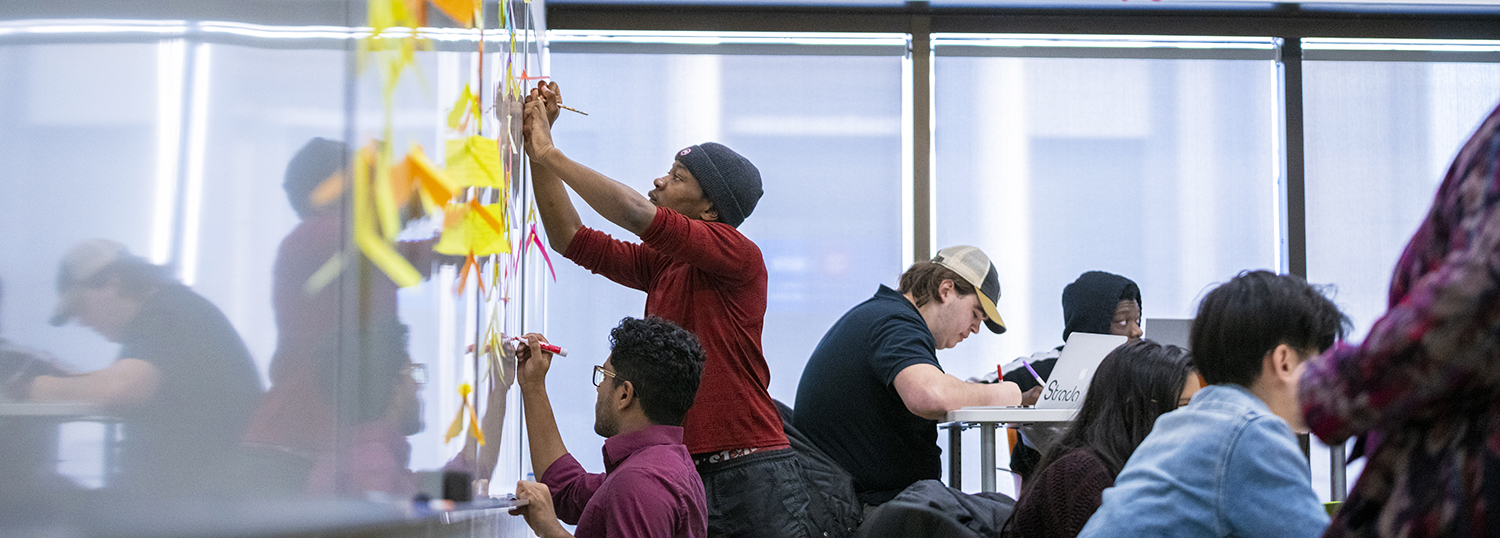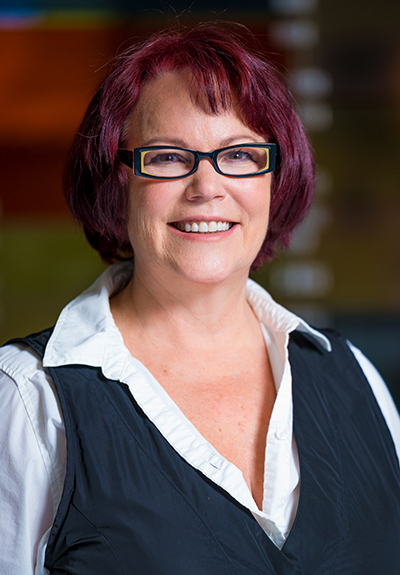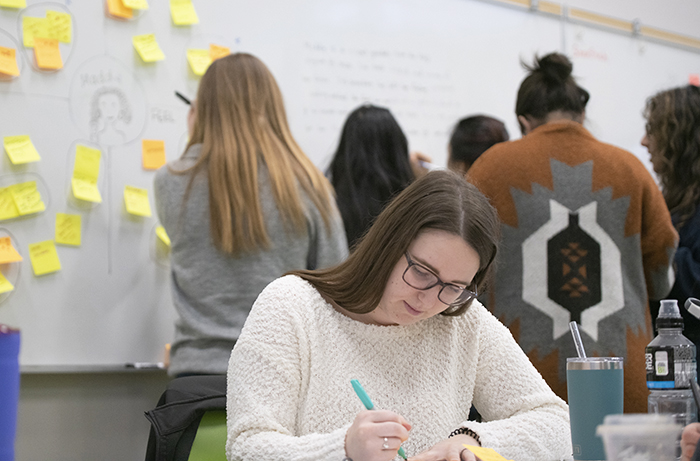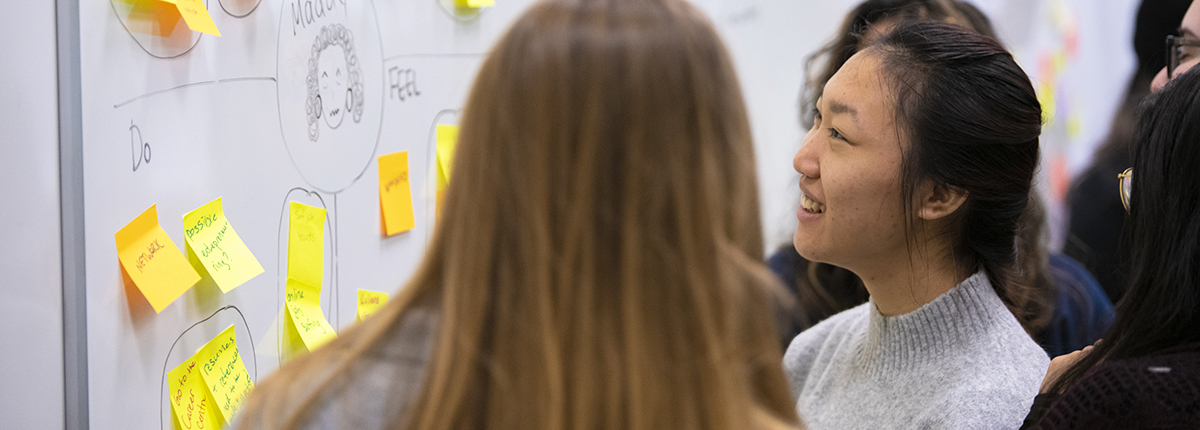
Photography by John Ternan
“There’s got to be a better way to do this.”
Many of us have muttered this phrase under our breath at least once in our lives, whether you’ve had difficulty navigating a website, downloaded an app to solve a problem, or stood in a seemingly endless line to complete a simple task like changing your address.
Students in the User Experience (UX) Design program at Wilfrid Laurier University are trained to understand those pain points and are seeking real solutions.
UX Design is one of the fastest-growing fields across all industry sectors. But, for many, just what it is and why it matters remains a mystery.
“There’s hardly an area today that you can’t imagine not being touched by UX designers and that’s why it’s such a great avenue for employment,” says Abby Goodrum, coordinator of Laurier’s UX Design program. “UX designers design experiences. They can be product experiences such as a hairdryer or a chair, or digital technology experiences like software or an app. They can also be hybrid experiences like government services, or immersive experiences like theme parks.”

Abby Goodrum, coordinator of Laurier’s UX Design program.
Laurier’s UX Design program will mark a milestone in June, when students in its first graduating class receive their degrees. It will be a memorable moment for the students, but also for Goodrum, who worked to launch Laurier’s UX program in 2017.
“The great thing is that many of our students are coming to us with a desire to make something better in the world,” says Goodrum. “Our response to that is, ‘Well, you can use UX to do that.’”
Employment opportunities in the field of UX design first emerged during the late 1990s. At the time, UX design was practiced using a mix of psychology, human-computer interaction, graphic and web design, marketing, and information technology. When Goodrum sought to develop a UX program at Laurier, she did what any UX designer would do: used the UX design process to understand and create the curriculum.
To develop the program, she spoke with more than 200 industry professionals in Canada and beyond to learn everything possible about the field and what UX design employers would look for in a graduate. The program’s curriculum is continuously tested and tweaked to provide students the most relevant education possible.

Laurier’s UX Design program is one of Canada’s only UX programs that emphasizes both digital and physical design.
“We are constantly doing the thing that is so important in UX design, which is iterative prototyping and testing,” says Goodrum.
Laurier’s UX Design program was unique when it welcomed its first students in 2017, as it was one of the only degree programs in Canada focused on the field. Students in the program take a mix of classes that provide the skills needed for UX, including web design, graphic design, immersive space design, research and interaction design.
– Maria Lobbezoo
“Students gain the breadth of skills that go into UX design, but many of our students will delve into one or two of the areas that they’re really passionate about,” says Goodrum.
Laurier’s program is one of Canada’s only UX programs that emphasizes both digital and physical design, including products, services and spaces.
Despite its increasing importance, the field of UX design remains relatively unknown among students entering post-secondary studies from high school.
First-year Laurier student Maria Lobbezoo says she didn’t know about UX until after she started her post-secondary education. After reading The Design of Everyday Things by Don Norman, required reading for many design students, she fell in love with the field and decided to join Laurier’s UX Design program.
“Once you become aware of UX, you see that almost every interaction you have in your daily life was thoughtfully designed by someone else,” says Lobbezoo. “What I love about it most is that it's focused on understanding problems and coming up with solutions.”
During her first semester, Lobbezoo won a $1,000 scholarship for an app prototype she created. The award was made possible by a donation from Scotiabank that supports experiential learning, scholarships, work experience and design competitions for UX students at Laurier.
Industry partners have played a big role in informing Laurier’s UX curriculum. Because of that, they have a continuing interest in supporting Laurier students, which takes the form of portfolio-building classwork, co-op placements, workshops, internships and employment opportunities.
“Our industry partners bring real projects into our classroom and our students work on real UX projects from their very first semester,” says Goodrum.

Laurier UX students work with real-world businesses and have the opportunity to pursue an optional co-op placement after their third year of studies.
For Fatima Khan, a third-year student and president of Laurier’s User Experience Design Student Association, UX was a way to combine her interests in creative arts and science, technology, engineering and mathematics.
“Since our first class, we were partnered with a client and gained so much hands-on experience,” says Khan.
– Sidhant Kapahi
Laurier UX students work with real-world businesses including D2L, IBM, McAfee, RBC and Scotiabank, as well as non-profit organizations including Brantwood Community Services in Brantford and the Shore Centre in Waterloo. They also have the opportunity to pursue an optional – but highly competitive – 12- to 16-month co-op placement after their third year of studies.
This summer, Khan will be starting a co-op placement at Ontario Digital Service, a branch of the Ontario government that aims to deliver simpler, faster and better digital services to citizens.
“I’m excited to work there because at Ontario Digital Service you are designing something that has such a big impact on all of the people who live in Ontario,” says Khan. “The way you tailor your design shifts the way people experience Ontario’s services and navigate their day-to-day lives.”
Sidhant Kapahi is finishing a co-op placement at RBC, where he’s been working in multiple UX roles through RBC’s student Amplify Program.
“We get to look at what it means to innovate at a bank,” says Kapahi. “We get to experiment, think outside the box and try new things.”

Goodrum says the COVID-19 pandemic has shown the importance of good design and user-friendly online spaces.
“People who may not have ever thought that they were going to have to do all of their business online before suddenly realized they do,” says Goodrum. “People who never thought they would, or were never allowed to, work from home are now mandated to. That’s changed everything.”
Noah Lach has also seen a considerable shift in user experience due to the pandemic. He started his placement with D2L, a Kitchener-based education software company, shortly after the pandemic hit Canada last winter. Lach was recently hired as a full-time employee and will continue to work with D2L as he completes his degree at Laurier.
“D2L is a company that really values design and they care about accessibility throughout every part of their design process,” says Lach. “It’s really inspiring.”
While Laurier UX Design students enjoy impressive job prospects, Goodrum says the philosophy behind the program remains simple at its core: “making the world a better place, one experience at a time.”
– Abby Goodrum
“This is a great degree program to go into if you want a job,” says Goodrum. “But our students are also coming away with a larger picture about how to have empathy for people and develop solutions to real problems in the world.”